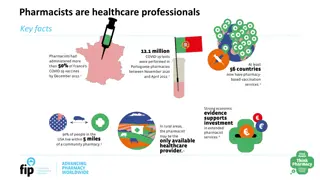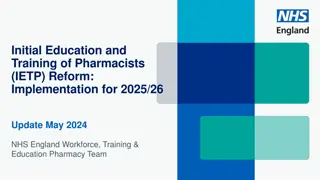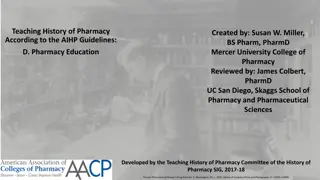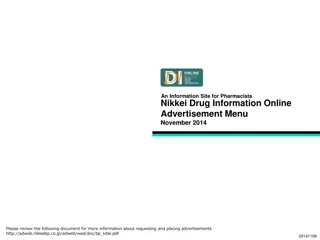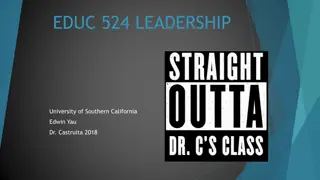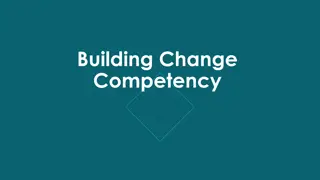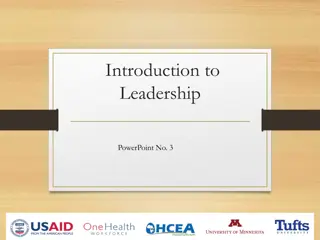Developing Future Pharmacists: Training for Leadership and Change
Explore the innovative approach of training pharmacy students as leaders and change agents, emphasizing essential skill sets and the incorporation of Clifton StrengthsFinder program. Learning objectives include discussing the evolving skill requirements of future pharmacists, teaching and assessing leadership skills effectively, and sharing insights for implementing such curricula. Delve into the essential attributes student pharmacists should nurture and the structured course framework for their professional development.
Download Presentation

Please find below an Image/Link to download the presentation.
The content on the website is provided AS IS for your information and personal use only. It may not be sold, licensed, or shared on other websites without obtaining consent from the author. Download presentation by click this link. If you encounter any issues during the download, it is possible that the publisher has removed the file from their server.
E N D
Presentation Transcript
Training All Students as Leaders and Change Agents Rachel Allen, Pharm.D. Kelsey Brantner, B.S. Curtis G. Jefferson, M.S. Nanci Murphy, Pharm.D. Shannon Panther, Pharm.D., BCACP Jennifer D. Robinson, Pharm.D.
Disclosure During this presentation we will be discussing how we utilized Clifton StrengthsFinder program. We are not commercially supporting or endorsing Clifton StrengthsFinder, just providing information about how we used this product as part of our broader leadership development approach.
Learning Objectives 1)Discuss the skillset needed by a Doctor of Pharmacy graduate in the next 5-10 years. 2)Identify how leadership skills can be effectively taught and assessed in a required course in a doctor of pharmacy curriculum. 3)Discuss lessons learned and recommendations for offering this type of curricula.
Training the Pharmacist of the Future
Active Learning: Brainstorm What is your vision for the skillset that a pharmacist will need to practice pharmacy in the near future?
CAPE Educational Outcomes Student Pharmacists should develop the following skills or attributes; learner, caregiver, manager, promoter, provider, problem solver, educator, advocate, collaborator, includer, communicator, self-aware, leader, innovator and professional.
IPPE Course Structure UW WSU Fall PY2, immediately after Community IPPE Quarters Semesters Classes every other week Classes every week Credit/No Credit 84% threshold to earn credit Asynchronous Delivery Graded Professionalism Credit
Course Coordination Across Universities Scheduled calls Maintained call notes with assigned tasks Google docs vs. Dropbox Deadlines IOR calls approximately one week prior to module
4 Course Foundations Application in Community Pharmacy Leadership Teamwork Strengths
Pre-Course Survey Pre-Course survey utilized to determine each student s prior background with: Leadership and change Strengths Teamwork Implementing a new service and/or improving existing service in a community pharmacy setting Assessed baseline perceptions regarding each student s perceived abilities in the above areas Completion required before classes began
Leadership Module 1 Application in Community Pharmacy The Future of Pharmacy Practice IHI Triple Aim Introduction to Clinical Service Project
Module 1 Design Introduced to 4 foundations of course Leadership, Strengths, Teamwork, Application in Community Pharmacy Introduced Clinical Community Project & Community Pharmacy Partners Watched videos from Rear Admiral Scott Giberson and APhA CEO Tom Menighan Team formation Homework: Report to the U.S. Surgeon General Assignment IHI Assignment Complete Project Guide Parts 1-3
Video: Rear Admiral (RADM) Scott Giberson
Report to the Surgeon General Learning Objectives and IHI Triple Aim The Future of Pharmacy Practice Demands on healthcare delivery , pharmacist s role, determine the professional development steps needed to meet the need Outline IHI Triple aim goals and achievement with a new or enhanced clinical service Leadership regardless of title and characteristic of effective leaders Develop knowledge of organizational culture.
Clinical Community Pharmacy Project 3 Part Purpose Create, develop, and outline necessary implementation measures for a clinical service To Achieve One or more of the IHI Triple Aim goals To Advance The practice of pharmacy Apply knowledge gained during the Community IPPE
Clinical Community Pharmacy Project Groups Self-selected Group Size UW: 4-5 WSU: 7-8 Full autonomy over project idea ultimately pursued Some in-class time, but largely completed outside of class
Challenge-Based Learning Groups worked through a Challenge-based project guide to assist with the development of a new or enhanced clinical service. based on Apple s Challenge-based learning model adapted to fit the goals of this project Benefits of Challenge Based Learning: a. Hands on & collaborative b. Encourages use of technology c. Uses creativity to develop solutions d. Solves real-world challenges
Community Pharmacy Partners Pharmacists with a track record of innovation at their practice sites Pharmacists actively engaged in professional organizations and/or their communities Pharmacists who were supportive and experienced preceptors Pharmacists who were knowledgeable in the process for enhancing current or developing new services (e.g., business plans, marketing strategy, and financial analysis)
Leadership Module 2 Application in Community Pharmacy Strengths Leading Change (UW) Determining Personal Strengths
Module 2 Design Kotter s 8 steps for Leading Change (reviewed in class at UW) Community IPPE Project Time Homework: Strengths Assessment Assignment Personal Strengths Reflection Complete Project Guide Part 4
Kotters 8-Step Process for Leading Change Institutionalize the Change Build on the Change Create Quick Wins Empower Others to Act on the Vision Communicate Decisions Create a Vision Form a Guiding Coalition (team) Create Urgency "Kotter's 8-Step Change Model." Mind Tools: Essential Skills for an Excellent Career. Mind Tools Ltd., 2010. Web. 17 Feb. 2016.
Clifton StrengthsFinder 30-minute online assessment, the Clifton StrengthsFinder After you take the Clifton StrengthsFinder, you'll receive a customized report that lists your top five talent themes, along with action items for development and suggestions about how you can use your talents to achieve academic, career, and personal success.
The Four Domains of Leadership Strength Strategic Thinking Executing Influencing Relationship Building Achiever Arranger Belief Consistency Deliberative Discipline Focus Responsibility Restorative Activator Command Communication Competition Maximizer Self-assurance Significance Woo Adaptability Developer Connectedness Empathy Harmony Includer Individualization Positivity Relator Analytical Context Futuristic Ideation Input Intellection Learner Strategic Clifton, Donald O. StrengthsQuest: Discover and develop your strengths in academics, career, and beyond. Gallup Pr, 2002. Adapted from StrengthsQuest Four Domains What Makes a Great Leadership Team? . 2009.
Teamwork Application in Community Pharmacy Module 3 Strengths Applying personal strengths to a team and organization
Module 3 Design In class presentation on strengths by Leslie Fox Healthcare Policy and Advocacy Director at Johnson & Johnson Discussion on strengths in teams and how to use strengths strategically Homework: Team Strengths Reflection (HW for UW, covered in Module 4 for WSU) Complete Project Guide Parts 5-6
Active Learning: Brainstorm Strengths Application
Module 4 Community Project Pitch Preparation Putting it all together Application in Community Pharmacy Leadership Teamwork Strengths
Module 4 Design In class project prep time &/or team strengths discussion follow up Final time for review of grading rubric and questions regarding project pitch Homework: Project Pitch Preparation
Module 5 Project Pitch Presentations Application in Community Pharmacy Leadership Teamwork Strengths
Module 5 Design Presentations given live to classmates, teachers, and community pharmacy partners Panel of community partners ideal for the presentation evaluation (UW) All presentations evaluated in real time, but were also recorded High scoring projects that drew community partner interest in implementation were invited to continue their project Homework: Team Member Evaluation Post Course Survey
5 Minute Project Pitch A final project overview was presented to practicing Community Pharmacists and the class at the conclusion of the course. This presentation was each team s sales pitch for the project. The pitch had to be 5 minutes or less. The audience was encouraged to ask questions on material that is unclear. The pitch could be presented as a verbal presentation, video, skit, etc. Students were provided with a project pitch guide & rubric to help you prepare.
Quotes from Community Partners Jenny Arnold, Pharm.D., BCPS, Director of Practice Development - Washington State Pharmacy Association: Having the students present their Leadership Projects, in only 5 minutes gave them the challenge of refining their work down to the essence, and presenting just the most important aspects. This is a great skill for any pharmacist to have when they want to promote something to leaders, their patients or the community. Beverly Katterman, Clinical Professor, Owner Katterman s Sand Point Pharmacy: "I think that all the groups should receive an A for thinking outside of the box."
How Groups Were Chosen for Implementation Ranked based on presentation rubric Highly ranked projects were given the option to implement project (UW) community partners gave input on what projects could be implemented at their pharmacy; other student groups were given options for implementation at other sites (WSU) Highly ranked projects were given the option of contacting other community pharmacies if their project could not be done with the original community partners
Highlights of student projects
Project Implementation WSU 1)Creation of rural health care screening services in three North Idaho pharmacies 2)Student lead development and delivery of a MTM elective course for fellow student pharmacists
Project Implementation UW 1)Assist community pharmacists in improving 5-star ratings criteria related to medication adherence 2) Expand the pharmacist s involvement in management of patients diagnosed with heart failure in clinic settings
Assessment Student Confidence Kotter s 8 Steps of Change Factors Influencing Change in Confidence Pitch Presentations Key Takeaways
Student Confidence Seven questions asked on pre and post surveys Assessed using PRE-THEN-POST model Statistically significant increases in PRE-POST and THEN-PRE scores in all seven areas
Student Confidence Confidence Area (n=191) Then (SD) Pre (SD) Post (SD) p Leading Change 54.895 (3.139) 63.474 (3.072) 70.947 (2.46) p < 0.001 Identifying & Describing Personal Strengths 61.368 (2.711) 73.789 (2.651) 80.947 (2.154) p < 0.001 Identifying & Fostering Strengths in Others 60.211 (2.948) 68.534 (2.716) 75.211 (2.557) p < 0.001 Identifying New Services 52.316 (3.066) 58.482 (3.149) 72.105 (2.48) p < 0.001 Developing a Plan 52.632 (3.247) 58.337 (3.113) 75.053 (2.512) p < 0.001 Implementation 54.421 (3.394) 61.414 (3.122) 73.579 (2.523) p < 0.001 Creative Decision-making 57.526 (3.238) 63.351 (3.176) 74.737 (2.599) p < 0.001
Kotters 8 Steps of Change Asked students for areas where they feel they improved and where they feel comfortable Top 3 in Both Areas Communicate Decisions Create a Vision Form a Guiding Coalition (team)
Kotters 8 Steps of Change Improved Areas in Leading Change (n=192) Number % Create Urgency 56 29.17 Form a Guiding Coalition (team) 106 55.2 Create a Vision 124 64.58 Communicate Decisions 142 73.96 Empower others to act on the vision 91 47.4 Create Quick Wins 59 30.73 Build on the Change 84 43.75 Institutionalize the Change 49 25.52
Kotters 8 Steps of Change Comfortable Areas of Leading Change (n=192) Number % Create Urgency 75 39.06 Form a Guiding Coalition (team) 105 54.69 Create a Vision 118 61.46 Communicate Decisions 145 75.52 Empower others to act on the vision 96 50 Create Quick Wins 66 34.38 Build on the Change 100 52.08 Institutionalize the Change 49 25.52
Influencers of Change in Confidence Students asked to identify what contributed to changes in leadership confidence
Influencers of Change in Confidence Factors Influencing Change In Confidence (n=128) Number % Group Project 73 57.03 Learning About Change 35 27.34 Strengths Finder 27 21.09 Motivation/Drive 10 7.81 Learning About Leadership 9 7.03 Increased Knowledge of Pharmacy Practice 3 2.34 IPPE 3 2.34
Pitch Presentations Average student performance on pitch presentations was 26.47 on 30-point scale Reviewers reported being very impressed with overall quality of student work
Key Takeaways Students report feeling more confident and comfortable with leadership and change Students report group project as the most commonly cited factor in influencing this change



